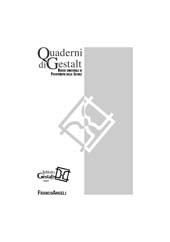Una lettura gestaltica dei disturbi psicosomatici : "la pelle che brucia"
33-50 p.
Nel presente articolo viene proposta una lettura gestaltica del trattamento dei disturbi psicosomatici. Dopo una descrizione del costrutto da un punto di vista diagnostico e l'efficacia dei trattamenti psicoterapici, viene presentato il contesto culturale di riferimento e la terapia della Gestalt come approccio possibile per la cura. Viene pertanto proposta una lettura integrata che comprende aspetti biopsicosociali. Il caso clinico presentato definito dagli autori "una pelle che brucia", mette in evidenza come la Conoscenza Relazionale Estetica possa aiutare nella presa in carico dei disturbi psicosomatici, nella misura in cui l'altro viene compreso nel campo relazionale e accolto nella sua specificità. In conclusione, diventa necessario valorizzare tutte le esperienze nel loro complesso (fisiche, psichiche, sensoriali ed emotive) perchè dal funzionamento unitario di "corpo", "mente" e "ambiente" emerge un processo figura-sfondo vivo. [Testo dell'editore]
This article presents a Gestalt perspective on the treatment of psychosomatic suffering. The first section outlines the development of psychosomatics within psychoanalytic studies. It explores the diagnostic framework and the effectiveness of psychotherapeutic treatments, contextualized within the post-pandemic period, the climate crisis, and ongoing global conflicts. Gestalt therapy is then introduced as a potential approach, emphasizing the experiential and situational field concept to deepen the understanding of the aetiopathogenesis and phenomenology of psychosomatic disorders. The relational and intersubjective dimensions of bodywork are discussed, highlighting the indispensability of mind-body unity alongside the centrality of the therapeutic relationship. The authors provide an integrated biopsychosocial perspective on psychosomatic disorders, examining the interactions among the nervous, immune, and endocrine systems
A clinical case demonstrates how Aesthetic Relational Knowledge can effectively address psychosomatic suffering by understanding the patient within a relational context and acknowledging their specificity and uniqueness. The importance of co-regulation and the therapist's adaptive presence is emphasized to support the patient in managing closeness within the therapeutic relationship. This relational "dance" relies on trust in the field, particularly during moments of discouragement and pain when the patient feels unseen or invalidated. Over time, this process facilitates co-regulation and the resolution of symptoms by recalibrating the therapeutic distance.nclusion, Gestalt psychotherapy, grounded in Aesthetic Relational Knowledge, emerges as a privileged approach for treating psychosomatic disorders. This is achieved through the integration of the patient's mind-body experience in the therapeutic here and now
The treatment is founded on the therapist's authentic and spontaneous presence, which acknowledges the patient's complexity without disregarding the neurobiochemical correlates that exacerbate suffering. Phenomenologically, the therapist becomes part of the patient's experiential field, using resonance to comprehend the patient's lived experience. By embodying the patient's experience metaphorically \u0022on their skin\u0022, the therapist facilitates the reformulation of relational patterns and fosters new creative adaptations. [Publisher's text]
-
Articles from the same issue (available individually)
-
Information
ISSN: 2035-6994
KEYWORDS
- Psicoterapia della Gestalt corpo risonanza Conoscenza Relazionale Estetica psicosomatica
- Gestalt psychotherapy psychosomatic body resonance Aesthetic Relational Knowledge


